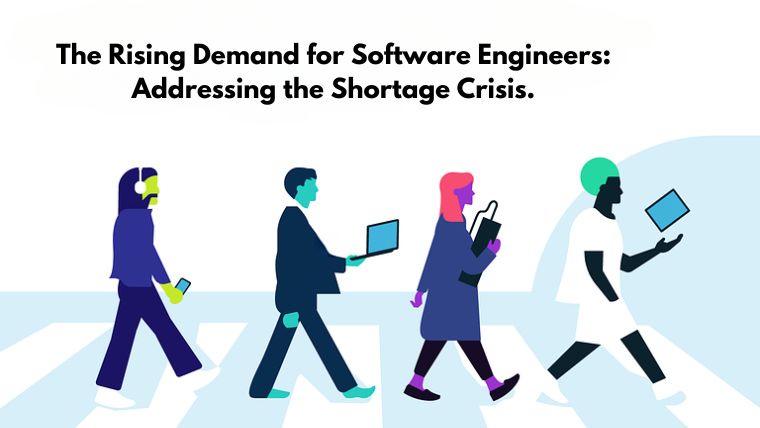In the rapidly evolving tech landscape, the demand for skilled software developers is soaring, particularly in areas like blockchain, AI, web, and app development. This high demand signals a promising future, but the persistent shortage of skilled developers poses a significant challenge. As businesses strive to innovate and stay competitive, addressing this shortage becomes crucial.
Empowering businesses with access to AI technology not only addresses the developer gap but also propels fresh ideas and advancements in the industry. To overcome this hurdle, consider leveraging Hire dedicated dot net developers for a resilient and competitive edge in the dynamic tech ecosystem.
Key Statistics at a Glance
Amidst soaring demand, the industry grapples with a persistent shortage of developers, impacting businesses of all shapes and sizes. The scarcity extends across diverse sectors, as virtually every company requires technical talent for application development and maintenance. Let's delve into key statistics highlighting the pressing demand for software developers:
- IDC projects a surge in the global shortage of full-time software developers, escalating from 1.4 million in 2021 to a staggering 4.0 million.
- The US Bureau of Labor Statistics anticipates a robust 25% growth in employment for software developers, quality assurance analysts, and testers from 2021 to 2031, surpassing the average for all occupations.
- Pluralsight's 2023 State of Upskilling report reveals that 47% of tech workers shoulder additional responsibilities due to workforce reductions in their organizations.
- BCG reports that a substantial 73% of digital workers plan job changes within 2 to 3 years, with 40% actively seeking new opportunities.
- In the US, Korn Ferry's study reveals a significant gap, with job openings for software developers outnumbering qualified applicants at a ratio of 10 to 1.
Factors Contributing to the Software Developer Shortage
1. Rapid Technological Advancements:
- Challenge: The ever-accelerating pace of technological advancements poses a challenge to keeping educational curricula up-to-date.
- Impact: Developers face the constant need for upskilling to match the demands of emerging technologies like AI, blockchain, and IoT.
2. Educational Gap:
- Challenge: Educational institutions often struggle to align their programs with the rapidly evolving tech landscape, leading to a gap between academic offerings and industry requirements.
- Impact: Graduates may lack the practical skills and current knowledge needed by employers, exacerbating the shortage.
3. Global Competition:
- Challenge: Tech companies worldwide compete for a limited pool of skilled developers, intensifying the shortage.
- Impact: Organizations may face talent acquisition challenges, particularly in regions with high demand and limited local supply.
4. Demographic Shifts:
- Challenge: The aging workforce in certain regions, coupled with lower interest among younger generations in pursuing tech careers, contributes to a dwindling pool of experienced developers.
- Impact: An increasing number of retirements and a smaller influx of new talent create a talent scarcity in the industry.
5. Lack of Diversity and Inclusion:
- Challenge: The tech industry has historically struggled with diversity and inclusion, limiting the representation of underrepresented groups.
- Impact: By excluding diverse perspectives, the industry misses out on a broader talent pool, perpetuating the shortage and hindering innovation.
Addressing the shortage:
- Education Reform: Collaborate with educational institutions to update curricula, emphasizing practical skills and aligning with industry needs.
- Global Collaboration: Encourage international partnerships to share and mobilize talent across borders.
- Diversity Initiatives: Prioritize diversity and inclusion efforts to tap into a more extensive talent pool and foster innovation.
- Continuous Learning: Support initiatives for ongoing upskilling and reskilling to bridge the gap between emerging technologies and workforce skills.
Recognizing and addressing these contributing factors is crucial for developing sustainable solutions to alleviate the shortage of software developers and ensure a robust and adaptable workforce for the future.
Potential Solutions for the Software Developer Shortage
1. Education and Training Programs:
- Implement Industry-Relevant Curricula: Collaborate with educational institutions to develop curricula that align with industry needs, emphasizing practical skills and emerging technologies.
- Support Online Learning Platforms: Encourage the use of online platforms for continuous learning, providing accessible resources for aspiring and existing developers.
2. Global Talent Mobility:
- Streamlined Immigration Processes: Advocate for simplified and efficient immigration processes to facilitate the movement of skilled developers across borders.
- International Collaboration: Promote global collaboration and partnerships to share talent resources and address shortages collectively.
3. Diversity and Inclusion Initiatives:
- Targeted Recruitment: Implement inclusive hiring practices to attract a more diverse range of candidates.
- Support Underrepresented Groups: Establish programs and initiatives to support underrepresented groups, fostering an inclusive and varied talent pool.
4. Apprenticeship and Mentorship Programs:
- On-the-Job Training: Develop apprenticeship programs that provide practical, on-the-job training for individuals aspiring to enter the field.
- Mentorship Networks: Facilitate mentorship programs connecting experienced developers with newcomers to accelerate skill development.
5. Agile Workforce Development:
- Flexible Working Arrangements: Embrace remote and flexible working arrangements to tap into a broader geographic pool of talent.
- Continuous Learning Culture: Foster a culture of continuous learning within organizations, encouraging developers to stay updated on the latest technologies.
6. Public-Private Partnerships:
- Investment in Tech Education: Collaborate with the private sector to invest in tech education programs, creating a more skilled workforce.
- Government Incentives: Provide incentives for companies to engage in initiatives that address the shortage, such as supporting educational programs.
7. Automation and Low-Code Platforms:
- Promote Low-Code Development: Encourage the use of low-code platforms to empower non-developers to contribute to application development, reducing the demand for highly specialized developers.
- Automation Tools: Embrace automation tools to streamline repetitive tasks, allowing developers to focus on more complex and value-added activities.
Addressing the software developer shortage requires a multifaceted approach involving collaboration between educational institutions, governments, and industry stakeholders. Implementing these solutions can contribute to building a resilient and adaptable workforce to meet the demands of the rapidly evolving technology landscape.
Conclusion
In the face of a persistent shortage of skilled software developers, the tech industry grapples with challenges that impact innovation and business competitiveness. Addressing contributing factors such as rapid technological advancements, educational gaps, global competition, demographic shifts, and diversity issues requires a comprehensive strategy.
Solutions encompass education reform, global collaboration, diversity initiatives, continuous learning, apprenticeship programs, agile workforce development, and public-private partnerships.
Embracing automation and low-code platforms further alleviates the strain.
To navigate this landscape, businesses can leverage Hire dedicated asp.net developers fostering collaboration and innovation while overcoming the shortage with a resilient and adaptable workforce.


No comments yet